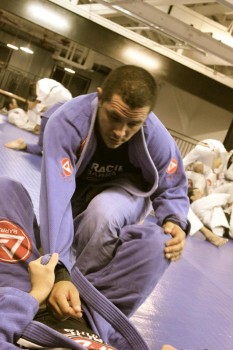4 Tips for Smaller BJJ Students
The lighter students in the bjj academy have it just a little tougher than their average (and larger) sized classmates. Contrary to the platitude, “size and strength DO matter!” Getting trapped under a heavier opponent that outweighs them by 50+ pounds is no fun! I am close to 200 lbs. bodyweight, which is heavier than average. So what can I possibly know about the challenges faced by the lighter practitioners?
While my reality is different than a 145 pounder, it also puts me at the lower end of the REAL heavyweights. The Japanese monster movie sized guys who could attack Tokyo when not at bjj! When it comes time to match the partners up, I am the lightest guy in the heavy class. I have spent much training time learning how to deal with these big guys and here are four tips for smaller BJJ students.
1) Keep moving / stop problems before they start
 Once the opponent’s weight is settled on you, it is an uphill battle to escape!
Once the opponent’s weight is settled on you, it is an uphill battle to escape!
There is an old saying “an ounce of prevention is worth a pound of cure”. As the lighter person, you must anticipate when a position is being lost (ex. your guard is being passed) and start your moving towards turtle or a different guard strategy BEFORE your opponent gains the grips they want.
Observe how a 150lb blackbelt deals with a much larger purple belt opponent. What are they doing to avoid directly opposing the larger opponent’s force?
They are moving their hips in the guard, maintaining distance and not allowing the big guy to really “get ahold of them” and apply their strength.
2) Floating positions on top
 I trained with a 145 lbs. black belt years ago who was able to control me from the top, but was not applying much pressure on me.
I trained with a 145 lbs. black belt years ago who was able to control me from the top, but was not applying much pressure on me.
I asked him why he didn’t use the shoulder in the face pressure and suffocating top weight that I understood as the best way to employ side control?
He replied that if he used pressure on me from the top, that he was effectively “locking” his smaller body to my larger mass. If I rolled, he would be forced to roll along with me and possibly ending up on bottom.
His top game was centered around knee on belly where he could control the top but not anchor his body to mine. He described it as “floating” on top of me as opposed to locking on.
Since then, knee on belly has been my favorite when on top of a larger opponent.
3) Find positions to keep the weight off of you
Many of the half guard bottom positions involve getting underneath your opponent, underhooking their leg in a deep half and undermining their base to sweep.
 It is great when it works, but when the opponent counters, you are flat on your back with 250lbs. sitting on your chest like a truck!
It is great when it works, but when the opponent counters, you are flat on your back with 250lbs. sitting on your chest like a truck!
Seeking another solution, I was led to the “Z-guard” or “knee shield” half guard that I found more effective in keeping the opponent’s weight off of me.
Using a “structure” or “bracket” of knees and elbows, I found a way to defend on the bottom even when my opponent was using strong forward top pressure.
Examine your bottom positions and ask yourself if there are variations that will be more effective in keeping the opponent’s weight off of your body.
4) Go for the back
In the movie “The Princess Bride” the hero, battling the Giant Fezik, jumps on his back.
How else would you defeat a giant?
Having the advantage of speed, a smaller guy can look for any opportunity to take the back and work for submission.
When you have the back, all of your weapons are pointed at your opponent and none of his are pointed at you. Larger opponents tend to be less mobile, and if your back control has been practiced enough, it can be very difficult for him to dislodge you.
Grandmaster Helio Gracie said that he favoured the choke over the armlock for the reason that an opponent might continue to fight even with an injured arm. The choke puts out even the most difficult opponents.
Please share in the comments your favorite advice for lighter students of bjj
Credits: Mark Mullen
Gracie Barra Black belt based in Taipei, Taiwan
Twitter: @MarkMullenBJ
Imagens: Google


